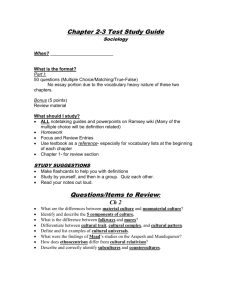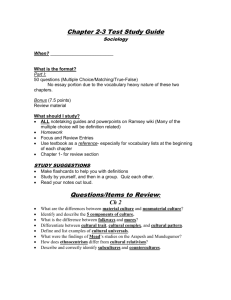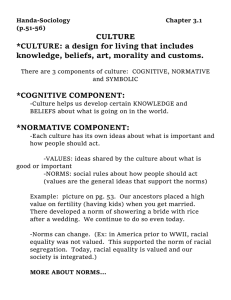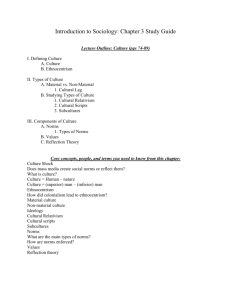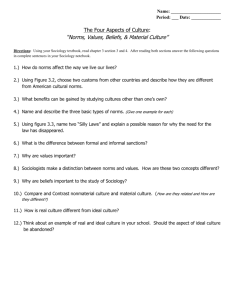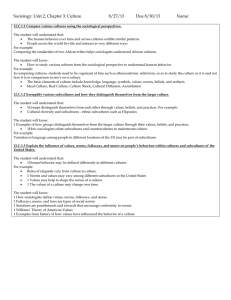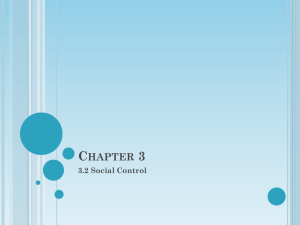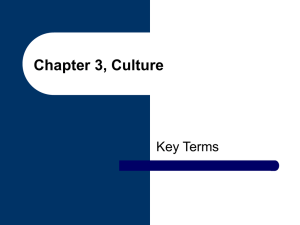Culture
advertisement
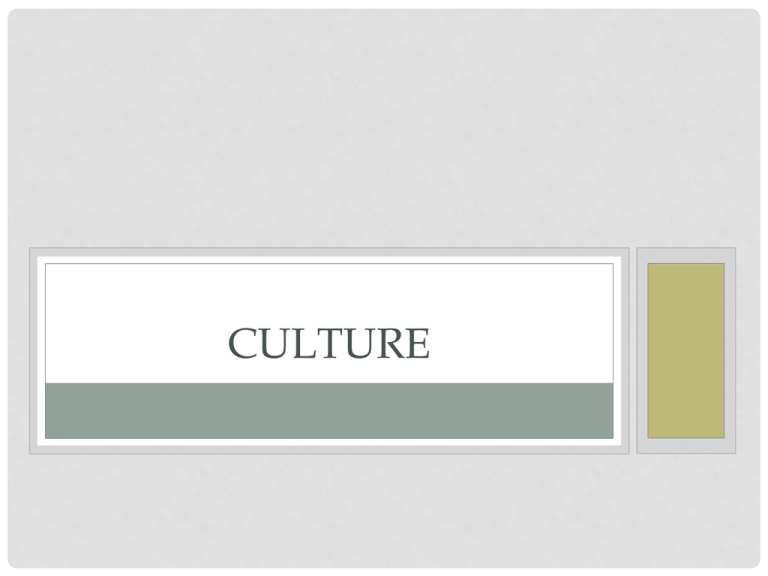
CULTURE WHAT IS CULTURE? • *CULTURE: a design for living that includes knowledge, beliefs, art, morality and customs. • Material Culture: physical object produced by humans reflecting the nature of society. • Non-Material Culture: intangible aspects of culture… • There are 3 components of culture: COGNITIVE, NORMATIVE and SYMBOLIC 3 COMPONENTS • COGNITIVE COMPONENT: • -Culture helps us develop certain KNOWLEDGE (objective) and BELIEFS (subjective) about what is going on in the world. • NORMATIVE COMPONENT: • -Each culture has its own ideas about what is important and how people should act. • SYMBOLIC COMPONENT: • Cognitive/Normative do not exist without this cultural component. A symbol is a word, gesture, music, or anything that stands for some other thing. A key example is language. • HSBC…Cultural Differences • http://youtu.be/GOHvMz7dl2A NORMATIVE COMPONENT • -VALUES: ideas shared by the culture about what is good or important • values are the general ideas that support the norms • -NORMS: social rules about how people should act • Example: picture on pg. 53. Our ancestors placed a high value on fertility (having kids) when you get married. There developed a norm of showering a bride with rice after a wedding. We continue to do so even today. • -Norms can change. (Ex: in America prior to WWII, racial equality was not valued. This supported the norm of racial segregation. Today, racial equality is valued and our society is more integrated.) MORE ABOUT NORMS… • FOLKWAYS: WEAK norms which specify expectations about proper behavior. You would NOT be punished for violating a folkway, but people might consider you to be rude. • MORES: STRONG norms which specify normal behavior and are DEMANDS (not just expectations). In most modern societies, most mores are formalized into laws. • INSTITUTIONALIZED DEVIANCE: a norm violation that is so prevalent it has become socially acceptable. • Ex: speeding, J-walking, speeding up at a yellow light • http://youtu.be/mU35XlTkLnA…Traffic Lights • SANCTIONS: the way in which a culture enforces norms are called sanctions. Sanctions can be positive or negative. • POSITIVE SANCTIONS: rewards for conforming to norms • Ex: congrats by friends, getting food or candy, getting a sticker, monetary reward • NEGATIVE SANCTIONS: punishment for violation of a norm • Ex: getting a dirty look, grounded, timeout NOT FINISHED WITH NORMS… • Some sanctions are applied by formal agents of social control such as the police and judges, but most often sanctions are applied informally by parents, neighbors, strangers, etc. • Values and norms do not describe actual behavior so much as they suggest how we should behave. We must remember that ideal culture differs from real culture, which is what actually occurs in everyday life. • IDEAL CULTURE: how people SHOULD behave • REAL CULTURE: how people ACTUALLY behave • Example: most men and women agree on the importance of faithfulness in relationships, yet a 2009 study in the U.S. found 17% of married people reported being unfaithful to their spouse at one point in their marriage (NORC). WHEN SANCTIONS AREN’T ENOUGH…WE HAVE VALUES. • Sanctions aren’t enough to produce the conformity to norms that occurs in cultures throughout the world. This is where values come into play. • Characteristics of VALUES (socially shared ideas) • They promote conformity • We learn them from socializing agents (media, peers, family, school) All containing a certain moral element. • They carry implied sanctions SYMBOLIC COMPONENT • Symbols help us communicate, share and transmit our culture to the next generation. A symbol is a word, gesture, music, or anything that stands for some other thing. • A key example of a symbol is language. Language does more than enable us to communicate, it also influences how we see the world. EDWARD SAPIR (1929) • Language not only helps us communicate, but also influences how we see the world • Human beings, he said, live “at the mercy of the particular language which has become the medium of expression for their society.” Sapir also wrote that language has “a tyrannical hold upon our orientation to the world.” When societies speak a different language, “the worlds in which societies live are distinct worlds, not merely the same world with different labels attached to it.” • This view was developed by Sapir’s student Benjamin Whorf (1956) and became known as the Sapir-Whorf hypothesis: language molds our minds, determining how we think about the world. • Example: Whorf found that the language of the Hopi Indians of the southwestern U.S. has neither verb tenses to distinguish the past and the present, nor nouns for times, days, seasons, or years. Consequently, according to Whorf, Hopi and English-speaking people perceive time differently. Although we see the difference between a person working now and the same person working yesterday, Hopi do not because their language makes no distinction between past and present. CRITICISMS OF SAPIR-WHORF HYPOTHESIS • The hypothesis overemphasizes the power of language. Language only influences – rather than determines – how we think. • If language determined thought, people who spoke different languages would always think differently, and it would be impossible for us to comprehend English translations of foreign languages. • Critics do admit that language has some influence on cognition. Virtually all social scientists agree that language influences perception and thinking, though they disagree on the amount of influence. U.S. POPULAR CULTURE • is part of the symbolic component. Pop culture is a collection of artistic creations that appeal to the masses of a society. • Mass culture is supported through U.S. democracy, which gives protection to free speech, even if it is offensive to some audiences. • Capitalism and the pursuit of profit leads to the effort to please consumers who want popular culture. (Demand for products, entertainment, etc., drives popular culture trends) • Feminists believe that popular culture is patriarchal and upholds the view that men are more important than women. • U.S. popular culture exerts a powerful cultural and economic influence on the world HIGH CULTURE V POPULAR CULTURE • High Culture: to refer to cultural patterns that distinguish a society’s elite • Popular Culture: to describe cultural patterns that are widespread among a society’s population. • We often speak less kindly of ordinary people, assuming that everyday culture is somehow less worthy. For example: We are tempted to judge a person who attends an opera as more “cultured” than a person who attends a hip-hop concert. • Common sense may suggest that high culture is superior to popular culture, but sociologists are uneasy with such judgments for two reasons: • Neither “elites” nor “ordinary” people share all the same tastes and interests; people in both categories differ in numerous ways. • Do we praise high culture because it is really better than popular culture or simply because its supporters have more money, power, and prestige? • http://youtu.be/uT3SBzmDxGk SUBCULTURES • simply put, a subculture is a culture within a culture. There is no total break with the larger culture. In modern cultures there are likely to be differences along many lines-such as gender, age, class or region. • VARIANT SUBCULTURES: differ from the dominant culture in some way-their values are still basically accepted by the larger culture as a whole. (ex: high school students) • COUNTERCULTURES: their values are not accepted by the larger culture as a whole, but are not generally considered to be illegal. (ex: hippies in the 1960s) • DEVIANT SUBCULTURES: their values are not accepted by the larger culture as a whole, and may be considered illegal. (ex: gangs) CULTURAL CHANGE • Every culture changes in order to adapt to the ever-changing physical and social environment. What drives Cultural Change in an environment? 1. Technology: Modern transportation and communication have made the world smaller, increased contacts among cultures, and accelerated the pace of change. • Technology also may create cultural lag: the social situation in which a culture’s values and beliefs fail to catch up with technology. (ex: Medical technology is lowering death rates in many poor countries, but traditional values and beliefs that favor having many children are not changing. The result of this cultural lag is overpopulation.) 2. Innovation: Cultures must support inventions and discoveries 3. Diffusion: The spread of things, ideas, beliefs or some other cultural items from one society to another. Diffusion results from contact between societies. Generally, the more contacts a society establishes with others, the higher its rate of cultural change. (ex: compare U.S. to North Korea) GLOBAL ANALYSIS OF CULTURE • CULTURAL UNIVERSALS: practices found in all cultures as the means for meeting the same human needs. (ex: food, shelter, symbols, language, clothing) • While cultural universals reflect the general means by which all societies meet their common needs, the specific content of these means varies from culture to culture. • From a very young age, we are taught that our way of life is good, moral, civilized or natural. At the same time we learn to feel that other peoples’ ways of life are not. The result could be ETHNOCENTRISM: the attitude that one’s own culture is superior to those of others. Ethnocentrism exists to one degree or another in every society. • The alternative to ethnocentrism is cultural relativism GLOBAL ANALYSIS OF CULTURE • CULTURAL RELATIVISM: the practice of judging a culture by its own standards - looking at a culture through the perspective of the people within the culture. • Cultural relativism can be difficult for travelers to adopt: it requires not only openness to unfamiliar values and norms but also the ability to put aside cultural standards we have known all our lives. Even so, as people of the world increasingly come into contact with one another, the importance of understanding other cultures will become even greater. SOCIOLOGICAL PERSPECTIVE ON CULTURE • Functionalist: Culture meets human needs • Most important function of culture is to ensure SOCIAL ORDER & STABILITY. • Conflict: Culture supports inequality • Culture represents the interests of the RICH & POWERFUL • Popular media distracts the exploited and the powerless • Symbolic Interactionist: Culture reflects shared understandings. • Stresses culture is a product of human creation • People use culture as a guide during interactions and conversations
